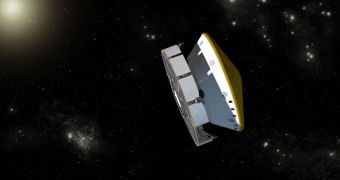Experts at the NASA Jet Propulsion Laboratory (JPL), in Pasadena, California, who manage the Mars Science Laboratory (MSL) mission, announce that they successfully completed a new course-correction maneuver yesterday, March 26.
Due to a series of technical factors, the spacecraft could not be launched on a direct course to the Red Planet. The rocket segment it's attached to cannot be allowed to enter our neighboring world's atmosphere, and potentially contaminate it with Earth-based lifeforms.
As such, the MSL was placed on a course that takes it away from the planet. Once the rocket segment separates, the probe will carry out a series of course adjustments that will put it on the correct track. This will also ensure that the rocket stage misses the planet by a wide margin.
The mission is not far away from its destination at this time. According to NASA, the MSL rover Curiosity will land in Gale Crater this August, less than 4 months from now. Developing a way to land the 1-ton Mini Cooper-sized vehicle on the surface of the Red Planet was a huge challenge.
Yesterday's maneuver was the second of six planned course corrections. The main thrusters aboard the MSL capsule were fired for nearly nine minutes, so that the spacecraft's momentum could be changed significantly enough. The success of the maneuver was confirmed from two individual sources.
“It is satisfying to get the second maneuver under our belts and know we are headed in the right direction. The cruise system continues to perform very well,” says the MSL maneuver systems lead expert, JPL scientist Erisa Hines.
“We are now on a trajectory that will put us much closer to the point we want to hit on Aug. 5,” adds the MSL navigation team chief, Tomas Martin-Mur. By April 1, the spacecraft is expected to reach the midway point between Earth and Mars.”
After launching from Space Launch Complex 41 (SLC-41) at the Cape Canaveral Air Force Station (CCAFS) on November 26, 2011, the mission is expected to land on Mars early on August 6 (UTC).
Last week also marked an important milestone in the flight. Mission controllers conducted a series of tests on all onboard systems, and determined that all 10 instruments are operational. The Radiation Assessment Detector (RAD) has already been collecting data for 3 months now.
“The types of testing varied by instrument, and the series as whole takes us past the important milestone of confirming that all the instruments survived launch,” concludes MSL science payload test engineer, Betina Pavri.

 14 DAY TRIAL //
14 DAY TRIAL //